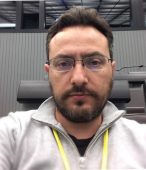Keynote Speakers

Professor, Dr. Klaus Peter Koch
Trier University of Applied Sciences, Germany
Short CV: Klaus Peter Koch was born in Wadern, Germany in 1972. He studied electrical engineering at the University of Applied Sciences in Saarbrücken (Dipl.-Ing. (FH) 1997). 2003 he finished his Ph.D. with the topic integration of intelligent micro-implants for stimulation and recording in neural prosthetics at the University in Saarbrücken. From 1998 to 2007 we worked at the Fraunhofer Institute for Biomedical Engineering. He was head of the neural prosthetics group at the same institute since 2004. 2007/2008 he was a full professor at the University of Applied Sciences Darmstadt and since 2008 he is a full professor at the University of Applied Sciences Trier (Germany). He works on the topic of electrophysiological measurement technics and implantable electrodes and electronics for 24 years (h-index/i10-index: 21/31). The research interest of Klaus Peter Koch is system integration for neural implants, design, and simulation of electrodes for recording and stimulation, medical electronics, and models for recording artifacts.
Keynote speech: In vivo interface for neural signals, Saturday 10 June, 11:00-11:30
Abstract: The development of interfaces between the human nervous system and technical systems involves a variety of challenges. Besides biocompatibility and biostability, these include selectivity and signal-to-noise ratio. The speech presents different electrode systems and their advantages and disadvantages for different applications. The application areas here range from brain interfaces for controlling prostheses to stimulation applications in neurodegenerative diseases and retinal implants. But also applications in the peripheral nervous system for stimulation of skeletal muscles or for stimulation of the autonomic nervous system are described. A special focus is on the construction of the electrodes. Classical methods of precision engineering but also microsystems technology are used. The difficulty with ever smaller electrode structures lies in particular in the robustness of the electrodes over a long application time in the body. The large number of electrodes required for visionary applications is also a major challenge. Computer-brain interfaces in particular, but also retinal implants, should be mentioned here. Here, both the electrodes themselves and their contacting to active implants up to their implementation in housings are technical challenges that entail high demands both in terms of production yield and long-term stability in the body. Despite these challenges, the medical application fields are constantly growing and lead to innovative approaches in all areas where an interface between technology and the nervous system is possible.

Associate Professor, Dr. Costas D. Arvanitis
Georgia Institute of Technology, Emory University, USA
Short CV: Costas D. Arvanitis is a joint Associate Professor at the G. W. Woodruff School of Mechanical Engineering and the W. H. Coulter Department of Biomedical Engineering at Georgia Institute of Technology and Emory University (2016-present). Prof. Arvanitis completed his doctoral studies at University College London at the Department of Medical Physics and Bioengineering in 2008. Subsequently, he did a two-year postdoctoral fellowship (2008-2009) at the Institute of Biomedical Engineering at the University of Oxford. He then carried on with his research at Harvard Medical School and Brigham and Women’s Hospital (2010-2016), where he reached the rank of Instructor. Prof. Arvanitis’ research program is in biomedical acoustics and is focused on two distinct subfields: therapeutic (focused) ultrasound and image-guided therapy. His team has conducted mechanistic investigations on ultrasound-meditated mass and drug transport in the brain and pioneered methods and technology for imaging and guiding therapeutic interventions in the brain. His lab is also particularly active in the field of brain cancer research, where they have developed controlled drug release and activation strategies and methods for spatially targeted immunotherapy and gene (siRNA) delivery in brain tumors. The research from his team has been disseminated to top-tier journals, including PNAS (2018), Nature Review Cancer (2020), and Science Advances (2021 and 2022). Prof. Arvanitis has already received several awards, including the Roberts Prize for the best article published in the Journal of Physics in Medicine and Biology (2014) and the Pathway to Independence (2014) and MERIT (2020) Awards from the National Institute of Health (USA).
Keynote speech: Ultrasound-enhanced Cancer Immunotherapy, Sunday 11 June, 11:00-11:30
Abstract: Conventional therapies for brain tumors (chemoradiation and tumor resection) are either ineffective or have significant toxicity and complications. As a result, cancer immunotherapy is increasingly tested for treating primary brain tumors. While early investigations are providing encouraging findings, they also highlight important challenges. These include i) limited therapeutic trafficking across physical barriers (blood brain barrier); ii) antigen loss or heterogeneity (limit chimeric antigen receptor T cell therapy); and iii) on- and off- target toxicity. This presentation will discuss how physical therapies such as ultrasound can overcome some of these challenges to enable safer and more effective brain cancer immunotherapy. Emphasis will be placed on the potential of ultrasound to i) improve the delivery and cytotoxic activity of immune checkpoint inhibitors in Glioblastomas; ii) control the cytotoxic activity of chimeric antigen receptor T cells in the brain tumor microenvironment in breast cancer brain metastasis and iii) guide cell-based therapy.

Senior Data and Analytics Engineer, Dr. Kostas Sidiropoulos
AstraZeneca, UK
Short CV: Dr. Konstantinos Sidiropoulos is a Senior Imaging & Deep Learning Engineer at the R&D IT department of AstraZeneca in Cambridge, UK. He was born in Kozani, Greece, in 1980 and he attained his Diploma in Biomedical Engineering from the Technological Educational Institute of Athens. Since then, he was involved in many EU-funded, research and innovation projects in Health. He successfully completed his Ph.D. in the domain of Medical Image Analysis and Machine Learning at Brunel University, London (2014). From 2014 to 2019 he worked as a senior software engineer at the European Bioinformatics Institute (EMBL-EBI) in Cambridge, UK, with significant contributions to the Reactome project. His current research interests include self-supervised training of large segmentation models, as well as distributed methodologies that allow training of gigantic models over large datasets.
Keynote speech: Designing a massively scalable, cloud-based, medical image ingestion pipeline for supporting research, Saturday 10 June, 11:30-12:00
Abstract: The industry-wide paradigm shift towards machine learning (ML) applications and especially deep learning models is mainly fueled by the availability of massive amounts of training data. It has been estimated that AstraZeneca is sitting on top of approximately 6 petabytes (PB) of medical and digital pathology images produced both by clinical and pre-clinical studies. Thus, the data ingestion requirements to support internal research groups are substantial. Here we discuss the motivation behind creating a scalable, serverless, low-cost ingestion pipeline as part of the Imaging Platform, and we outline all the lessons learned in the process, as well as the important technical challenges yet to be addressed.

Assistant Professor, Vice Chair, Dr. Irene Polycarpou
European University of Cyprus
Short CV: Dr. Irene Polycarpou is an Assistant Professor in Medical Physics and the Vice Chair of the Department of Health Sciences at European University Cyprus. She attained MSc and PhD degrees from King’s College London and undertook further postdoctoral research at St Thomas’ Hospital, London. Her primary research interest lies in the enhancement of the diagnostic value of Positron Emission Tomography (PET). Her research has advanced the state of the art in several fundamental ways including the creation of novel motion models using MRI information for PET. She has been involved in the development of simulated 4D PET-MR datasets that have been made freely available in academia and industry for the advancement of scientific investigation. Dr. Polycarpou’s research has been funded by several international bodies, including the Cyprus Research Promotion Foundation, the European Union with FP7, Erasmus+, and EU4Health projects. She is the incumbent President of the Cyprus Association of Medical Physics and Biomedical Engineering and an active member of the Board of the Society of Medical Physicists Cyprus. She is the country representative of Cyprus in one of the leading organizations in her field, the European Federation of Organizations for Medical Physics (EFOMP) as the National Member Organization (NMO) President. She has been also elected as a member of the council of the IEEE Nuclear Medical Imaging Sciences (NMISC).
Keynote speech: A Decade of Motion Management Developments in NM Imaging, Sunday 11 June, 11:30-12:00
Abstract: Management of subject motion in nuclear medicine imaging has been garnering sustained research and clinical effort for several decades now. Many methodologies have been developed for both single photon emission computed tomography (SPECT) and positron emission tomography (PET). Motion correction methodologies consist of three steps; motion tracking, motion estimation and motion correction. During the last decade considerable progress has been accomplished in motion tracking (stereoscopic or time-of-flight cameras, laser scanners, centroid of distribution algorithms, etc) and motion estimation (patient specific motion model, joint PET-MR image registration, population-based motion model, etc.). In regards to the step of correction, it has been proven that a highly accurate motion estimation does not guarantee the best possible imaging result because the way motion information used for generating the motion-corrected images (i.e. pre-, during or post-reconstruction) affects the overall performance of the correction. What makes motion management a challenging, ongoing investigation lies in the complexity of dynamic human anatomy, linked with the objective to improve the trade-off between image quality, patient dose and acquisition duration. The complexity of the implementation and the associated computational burden has so far limited the widespread acceptance of these methodologies in clinical practice. Due to these ongoing challenges, ongoing research is also considering how to improve existing methodologies in order to facilitate their adoption in clinical environments. In this talk we will discuss the advances and refinements on motion management in the field of nuclear medicine imaging over the last decade. Recent developments in artificial intelligence offers hope that it will find applicability also in the field of motion management, offering solutions to where current methods, so far, have failed.